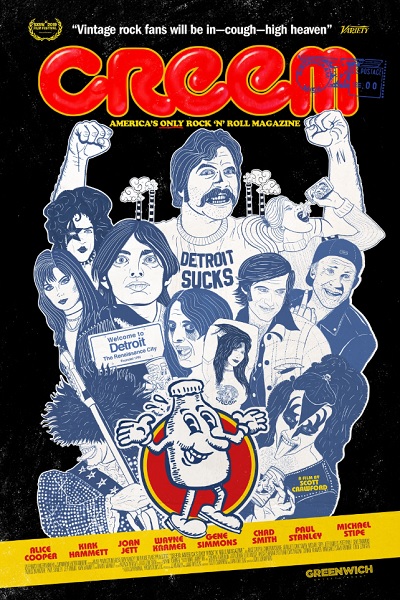As a teenager in the 1970s, I was obsessed with rock and roll. Posters of Led Zeppelin and the Beatles adorned the walls of my bedroom. Vinyl records and eight-track tapes filled the shelves of a makeshift entertainment center. And magazines like Rolling Stone, Circus, and Creem became my bibles, my backstage pass to a world I could only imagine and fantasize about.
With Rolling Stone, it’s always been a mixed bag of subject matters. Politics, TV, movies, books, music, pop culture — they do it all. I used to be a subscriber; now I read select articles online for free. In recent years, it’s become a polarizing publication with an assumed agenda and toxic reputation, so I tread lightly as a reader. Circus, by contrast, was a bit of a lightweight in terms of content. It covered all my favorite bands, had some great photos, and the articles were well-written. It just lacked a certain oomph. I stopped reading it after the 80s. It finally folded in 2006.
Which leaves Creem, which proudly staked the claim that it was “America’s Only Rock ‘N’ Roll Magazine.” Hmmm. The problem I had with Creem when I was a youngster was that I wasn’t in on the joke. Like Circus, it covered the bands I liked. Unfortunately, I was too young and naïve to appreciate the artistry, thought, passion, and humor behind it all. When I got a little older, I stumbled upon a short article in a 1980 issue of Creem called ‘Apocalypse Hooterville’ written by John Kordosh. It was in that moment that I realized just how brilliant, funny, witty, and irreverent the writers for Creem were. And now, 40 years later, we have Boy Howdy: The Story Of Creem Magazine, a documentary about the magazine and its quirky staff. One view in, and that same sentiment is stirring up a hearty serving of memories.
The film — produced by JJ Kramer (son of Creem co-founder and publisher Barry Kramer) and Jaan Uhelszki (one of the magazine’s star reporters in the 70s who also wrote the movie), and directed by Scott Crawford — begins with the story of Creem’s grassroots launch in 1969, then moves through key personalities and events in its 70s heyday before winding down rather suddenly about the magazine’s demise at the end of the 1980s. Clearly, after Barry Kramer and the magazine’s top maniac Lester Bangs were gone, Creem lost its edge and was never the same.
It’s a tale rich with unexpected highs and devastating lows as told by Creem insiders like Uhelszki, Dave Marsh, Dave DiMartino, Robert Duncan, Cameron Crowe, Connie Kramer, Greil Marcus, Neal Preston, and Bill Holdship. Other notable talking heads include Wayne Kramer (MC5’s guitarist who scored the movie), Alice Cooper, Jeff Ament (Pearl Jam), Chad Smith (Red Hot Chili Peppers), Michael Stipe (R.E.M.), Thurston Moore (Sonic Youth), Ted Nugent, Peter Wolf (J. Geils Band), actor Jeff Daniels, Paul Stanley, and Gene Simmons (KISS).
Visually, the film subsists on a steady flow of vintage footage, photos and animated sequences that provides the viewer with a good sense of how the whole scene unfolded. There are classic black and white clips of Kramer and his Creem team in action at the publication’s offices in and around Detroit. As we learn, the city, its working class ethos, and the whole Michigan music scene had an immense impact on the magazine’s somewhat subversive tone and style. Once the wheels got turning, regular features in the magazine figured prominently into the overall roadmap. Boy Howdy beer (not a real beer), Star’s Cars, Creem’s Profiles (which parodied Scotch maker Dewar and its Profiles), The Creem Dream, even the letters section — they all became an integral part of Creem’s appeal. If you were a regular reader, you’ll appreciate the refresher.
Barry Kramer and Dave Marsh (who may or may not have coined the term ‘punk rock’) most certainly are credited with getting the publication up and running, but, as the film clearly illustrates, it was Lester Bangs who kicked everything into overdrive. Notably characterized in Cameron Crowe’s movie, Almost Famous, Bangs was one part fan-boy, one part the Hunter S. Thompson of rock journalism. There’s a short clip of him in the film denouncing Emerson, Lake and Palmer as “musical sterility at its pinnacle.” Classic Bangs. His insatiable appetite to shock, insult, contradict, drink, drug, and hang out with rock stars — despite telling Crowe he should never befriend them — could easily be a movie all its own. For its part, the documentary shines a bright light on Bangs, once and for all dubbed “America’s greatest rock critic.” Perhaps there’s a subtle implication here that the magazine was never as vibrant after he quit (and refused to pay a $12,000 hotel bill) in 1976.
Nevertheless, Creem kept showing up at the newsstand for another 13 years. The loss of sparring with the likes of Marsh and Bangs, compounded with other psychological and chemical issues, sent Kramer into a downward spiral. His passing of a drug overdose in 1981 and Bangs’ overdose a year later — plus the advent of MTV, new wave and hair metal — suggested a sea change in how Creem would carry on. It was sold and moved to Los Angeles. And that’s pretty much where the story ends.
The greatest takeaway you’ll probably get from Boy Howdy: The Story Of Creem Magazine is that Creem was more like a band — with all its melodrama, lifestyle excesses, and passion for the art — than a magazine. Lester Bangs eventually got the rock star treatment wherever he went. But everyone who wrote, took photos, drew cartoons and contributed to Creem in one way or another, had a creative spark that made it so exceptional. They were given license to push it as far as it could go. Some went even further. You certainly can’t say that Creem, “America’s Only Rock ‘N’ Roll Magazine” — the one that offered “Super Cool Photos!”, “Outrageous Stories”, and “Bizarre Trash!” — didn’t live up to its name. Without reservation, Boy Howdy: The Story Of Creem Magazine does a remarkable job putting it all into perspective.
~ Shawn Perry




















